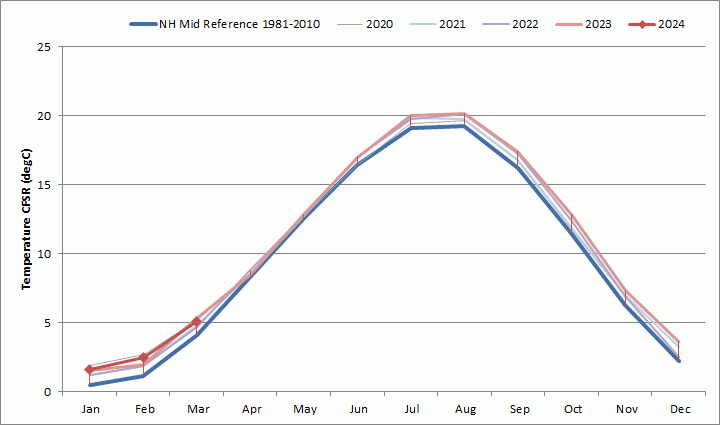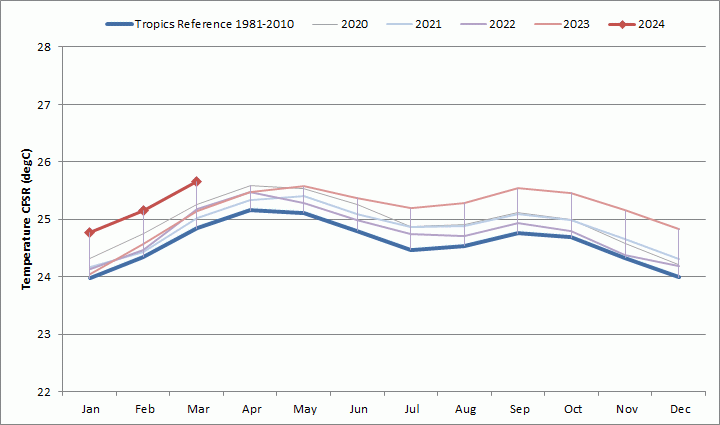The latest Climate Forecast System Reanalysis (CFSR) monthly global surface temperature anomaly and temperature estimates are graphed below (surface air temperatures at 2 meters above ground level). The most recent CFSR estimates since 2010 have been derived from Climate Data Assimilation System (CDAS) monthly output files provided by the U.S. National Centers for Environmental Prediction (NCEP). Earlier estimates were provided by the University of Maine Climate Change Institute (UM CCI) and are based on CFSR output. The CFSR is a reanalysis of input data using the Global Forecast System (GFS) which is initialized and run four times each day for routine weather forecasting. Monthly estimates through February 2024 are based on monthly CDAS output and for March 2024 are based on the average of daily CDAS output.
The first graph compares the adjusted CFSR (CFSR adj) with other monthly global surface temperature anomaly estimates, including the unadjusted CFSR (CFSR), European Centre for Medium-Range Weather Forecast (ECMWF) Reanalysis Interim adjusted (ERAI adj), US National Center for Environmental Information (NCEI), US National Aeronautics and Space Administration (NASA) Goddard Institute of Space Studies (GISS), the UK Hadley Climate Research Unit Temperature (CRUT), and the National Center for Atmospheric Research Reanalysis 1 (NCAR R1) Sigma 0.995, along with monthly global temperature anomaly estimates for the lower troposphere derived from satellite measurements provided by the University of Alabama at Huntsville (UAH) and by Remote Sensing Systems (RSS). All estimates have been shifted to the climatological reference period 1981-2010.
The CDAS preliminary monthly average global mean surface air temperature for March 2024 based on daily CDAS averages was 14.187C, which is the highest March since records began in 1979. The March 2024 global mean surface temperature anomaly (unadjusted) referenced to 1981-2010 was 0.751C compared to 0.870C for February.
The CDAS annual average global mean surface air temperature for 2023 was 15.077C, which is the highest since records began in 1979. The 2023 global mean surface temperature anomaly (unadjusted) referenced to 1981-2010 was 0.633C compared to 0.397C for 2022.
The next graph below shows the monthly estimated global surface temperature anomaly trend for the 21st Century so far (since 2001) from the CFSR adjusted for changes from Version 1 to Version 2. The current trend for this period is 0.00202C per month or 0.0242C per year and 0.727C if maintained for 30 years and to 2.42C if maintained for the entire century. Since this trend is based on 23 years of data, the projected trend is not likely to be very accurate beyond 10 to 20 percent of the observational period, which corresponds to only about two or three years.
The graph below shows the unadjusted CFSR monthly estimated global surface temperature anomaly trend for the 21st Century so far (since 2001). The current trend for this period is 0.00087C per month or 0.0104C per year and 0.313C if maintained for 30 years and to 1.04C if maintained for the entire century. Since this trend is based on 23 years of data, the projected trend is not likely to be very accurate beyond 10 to 20 percent of the observational period, which corresponds to only about two or three years.
The latest CFSR adjusted monthly global temperature anomaly estimates since 1979 are graphed below. The trend in estimated global temperature anomalies since 1979 is +0.00165C per month, +0.0198C per year, +0.594C per 30 years, and to +1.98C if maintained for 100 years. Since this trend is based on 44 years of data, the projected trend is not likely to be very accurate beyond 10 to 20 percent of the observational period, which corresponds to about 4 to 8 years.
The latest unadjusted CFSR monthly global temperature anomaly estimates since 1979 are graphed below. The trend in estimated global temperature anomalies since 1979 is +0.00127C per month, +0.0152C per year, +0.457C per 30 years, and to +1.52C if maintained for 100 years. Since this trend is based 44 years of data, the projected trend is not likely to be very accurate beyond 10 to 20 percent of the observational period, which corresponds to about 4 to 8 years.
The UM CCI provides monthly estimates of global temperature by latitude zones, including the non-overlapping Arctic (60N-90N), Northern Hemisphere middle latitudes (30N-60N), Tropics (30N-30S), Southern Hemisphere middle latitudes (30S-60S), and Antarctic (60S-90S). The temperature anomaly trends for these zones since 1979 are graphed below. Note that the scale of the vertical axis changes from zone to zone. Also note that the temperature trends progressively and consistently drop lower toward the south.
The trend in estimated Arctic zone (60N-90N) temperature anomalies since 1979 is +0.00434C per month, +0.0521C per year, or +1.562C per 30 years, and to +5.21C if maintained for 100 years. The likelihood of this trend extending for 100 years appears to be very small based on evidence of past oscillations in temperature and ice cover over periods of about 30 to 60 years in the Arctic zone. Thus, it is possible that Arctic temperatures will begin declining sometime in the next 5 to 10 years with the onset of the next cold phase. This pattern may be associated with the Atlantic Multidecadal Oscillation (AMO) and its influence on sea surface water temperatures in the Arctic. The Arctic zone only accounts for about 7 percent of the global surface area, but because of the very large anomalies that occur there, it can sometimes have a significant impact on the global average anomalies.
The trend in estimated Northern Hemisphere middle latitude (30N-60N) temperature anomalies since 1979 is +0.00198C per month, +0.0238C per year, or +0.713C per 30 years, and to +2.38C if maintained for 100 years. The Northern Hemisphere middle latitude zone accounts for about 18 percent of the global surface area.
The trend in estimated Tropical zone (30N-30S) temperature anomalies since 1979 is +0.00116C per month, +0.0139C per year, or +0.418C per 30 years, and to +1.39C if maintained for 100 years. The Tropical zone covers about 50 percent of the global surface area centered at the equator.
The trend in estimated Southern Hemisphere middle latitude (30S-60S) temperature anomalies since 1979 is +0.00059C per month, +0.0071C per year, or +0.212C per 30 years, and to +0.71C if maintained for 100 years. The Southern Hemisphere middle latitude zone accounts for about 18 percent of the global surface area.
The trend in estimated Antarctic zone (60S-90S) temperature anomalies since 1979 is -0.00157C per month, -0.0188C per year, or -0.565C per 30 years, and to -1.88C if maintained for 100 years. The Antarctic zone only accounts for about 7 percent of the global surface area, but because of the very large anomalies that occur there, it can sometimes have a significant impact on global average temperature anomalies.
The pattern of temperature trends for the Southern Hemisphere middle latitudes and Antarctic is not consistent with hypothesized significant man-made global warming. Since carbon dioxide concentrations are relatively uniform across the globe on a time scale of years and show persistent upward trends since 1979, these flat and downward temperature trends indicate that hypothesized man-made global warming is not dominant and that other factors are likely to be more dominant over the last 40 years. The implication is that observed upward temperature trends in the Northern Hemisphere are also being dominated by other factors. These other factors need to be resolved before any kind of accurate future climate predictions can be made. Predictions made assuming that man-made global warming is dominant are likely to fail.
The temperature anomaly trends hide the seasonal cycles that occur. The graphs below show the CFSR average temperatures for the same latitude zones graphed above as temperature anomalies. The CFSR estimated global monthly average temperature has a large seasonal cycle dominated by the Northern Hemisphere with a peak in July that is almost 4C higher than the minimum in January. This seasonal variation dwarfs the annual anomaly trend.
All of the latitude zones described above show seasonal temperature patterns as well. The largest monthly average temperature variation by far is for the Arctic zone with a range of about 25C from winter to summer. The Tropics zone exhibits the least variation at about 1C but has a double peak pattern with a secondary maximum and secondary minimum every year. The Tropics average maximum is for April with secondary maximum for September, and the average minimum is for January with secondary minimum for July. All other zones have seasonal patterns with maximums in zonal summer and minimums in zonal winter.
Another way to look at temperatures is by the seasonal pattern. The graphs below show the seasonal patterns for 2017, 2018, 2019, 2020, and 2021 so far compared to the most recent 1981-2010 standard climatological averages for each month based on the UM CCI CFSR data. Below is the graph for global average temperatures by month.
The Arctic zone (60N-90N) seasonal pattern is very similar to the global pattern, but much higher in amplitude. Notice that monthly average temperatures in the Arctic zone are above freezing for four months from June through September.
The Northern Hemisphere middle latitude (30N-60N) temperature pattern is similar to the Arctic zone, but shifted to higher temperatures.
Monthly average temperatures in the Tropics zone (30N-30S) show little variation through the year but exhibit a weak seasonal pattern with primary peak in April, secondary peak in September, primary minimum in January, and secondary minimum in July.
The Southern Hemisphere middle latitude (30S-60S) temperature pattern on average has a peak in February and a minimum in August.
Antarctic zone (60S-90S) monthly average temperatures peak well below freezing in January and on average show a minimum in August during winter as might be expected.
Access to monthly and daily CFSR data (requires Microsoft Excel):
https://oz4caster.files.wordpress.com/2024/03/cfsr-2024-03-01.xlsx
To comment about this page or to comment about the blog in general, use the “Comments” page in the menu bar at the top of this page.


















